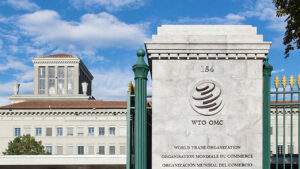
WTO expects stronger global trade in 4th quarter
THE World Trade Organization (WTO) said global merchandise trade will likely post strong growth in the fourth quarter, allowing it to maintain its global trade growth forecast of 0.8% in 2023 despite the impact of geopolitical disruptions.
In its Goods Trade Barometer, WTO said world merchandise trade volume was little changed in the second quarter.
The barometer is a composite leading indicator for world trade, providing an early indication of the trajectory of merchandise trade relative to recent trends, said the WTO.
The current value of the global trade barometer index is at 100.7 in September, which is above the latest reading for quarterly trade volume and close to the baseline value of 100.
“This suggests that merchandise trade volume will gradually revert towards its medium-term trend in the second half of 2023, although uncertainty remains high due to mixed economic data and rising geopolitical tensions,” WTO said.
However, it said that it expects trade statistics for the third and fourth quarters to come in stronger despite the geopolitical tensions.
“Trade statistics for the third quarter should come in slightly stronger thanks to faster gross domestic product growth in the US and China, even as the European Union economy continued to stagnate,” WTO said.
Rizal Commercial Banking Corp. Chief Economist Michael L. Ricafort said that this is also the same case for the Philippines.
“The continued economic recovery narrative in which more economies worldwide are moving further towards greater normalcy or are already above pre-pandemic levels support the normalization of global supply chains and the global trade,” Mr. Ricafort said in a Viber message.
He said that the reopening of China as well as the signals of “reduced odds of recession” in the US as gleaned from Federal Reserve statements point to stronger global trade.
For the fourth quarter, the WTO expects year-on-year trade growth likely to be strong “due to the slump that began in the same period last year.”
“These developments are consistent with the WTO’s forecast on Oct. 5, which foresaw an 0.8% increase in global trade volume in 2023,” WTO said.
“While the forecast remains unchanged, risks to the trade outlook have shifted towards the downside in light of recent developments in the Middle East,” it added.
The barometer’s component indices ended mixed during the period as some rose above the trend while others remained on or below trend.
Gains were seen in the indices for automobile sales and production (110.0) and electronic components trade (109.8).
The indices for air freight (100.3), export orders (99.4) and container shipping (98.0) finished on or slightly below trend, while the raw materials index (95.6) sank below trend, WTO said.
“The strength of the automotive products and electronic components indices may be explained by surging global demand for electric vehicles, while the weak result for raw materials may be partly due to weakening property markets as interest rates remain elevated,” the WTO said.
This is also the same case in the Philippines as electronics and semiconductors still comprise the biggest share in the country’s merchandise trade, said Mr. Ricafort.
However, he said that this will be further supported by continued and emerging innovation in electronics and semiconductors such as those related to artificial intelligence.
“Technological advancements in the automotive industry such as the greater shift to electric vehicles and self-driving vehicles will boost the global supply chains for batteries, nickel and other auto parts,” he said. — Justine Irish D. Tabile



